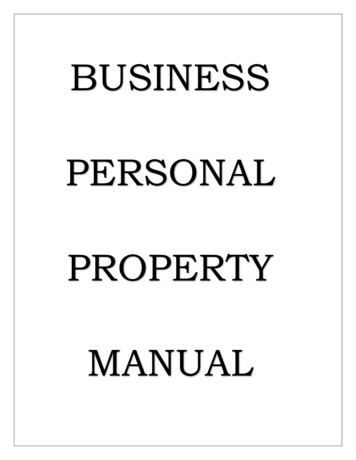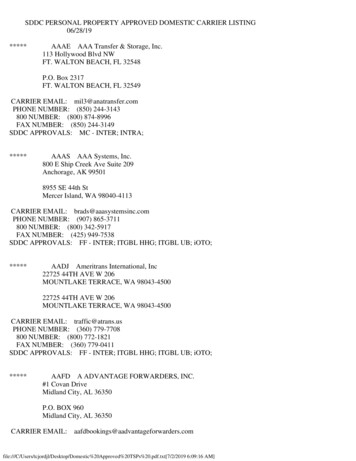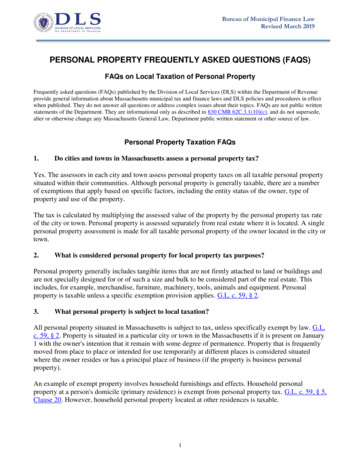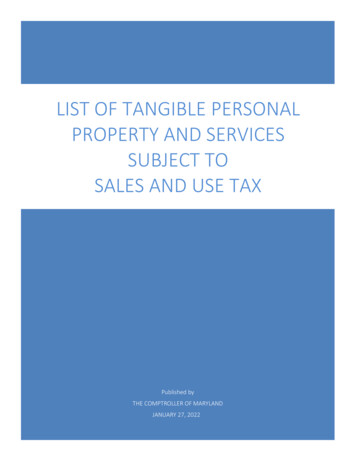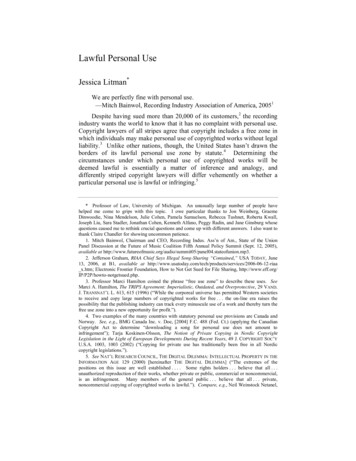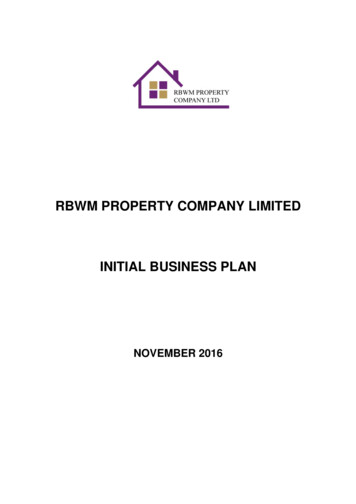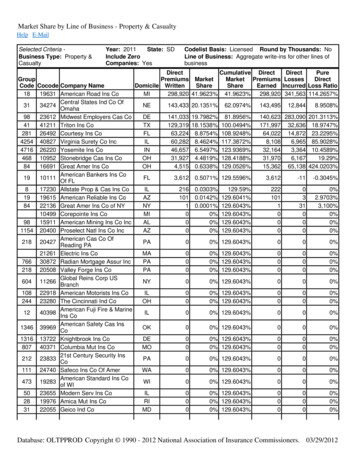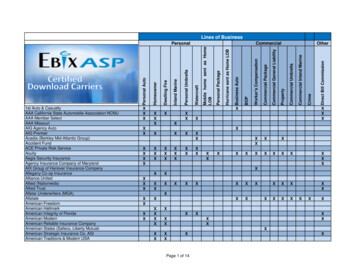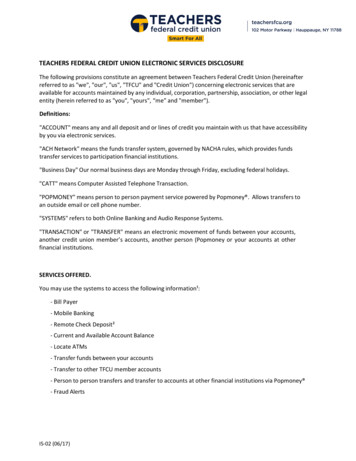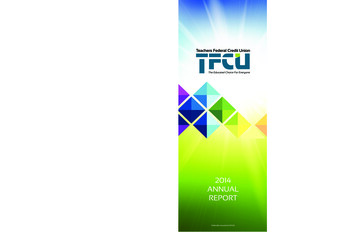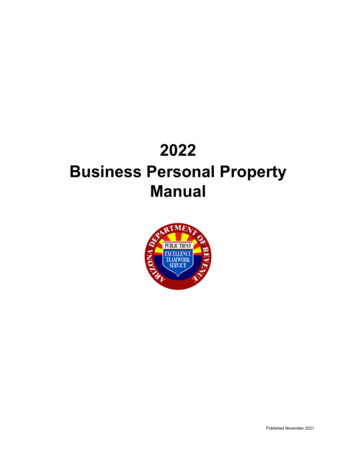
Transcription
2022Business Personal PropertyManualPublished November 2021
Business Personal Property ManualPrefacePrefaceIn 2018, the Department of Revenue (Department or ADOR) Manuals Team undertooka major project to update all publications produced by the Property Tax Unit. Thefollowing three levels of updates were to be applied, dependent upon the perceivedneed:Review: Publication conforms to standard style and formatting. Legislative and othercitations verified. No changes to content, methodology, policy, or practice.Revision: Includes applicable Review processes. Publication is newly edited.Nonsubstantive legislative changes incorporated. Addition or deletion of informationthat does not alter valuation methodology.Rewrite: Includes applicable Review and Revision processes. Major substantivechanges made to any combination of content, valuation methodology, policy, orpractice.This publication is a Rewrite of the 2021 Personal Property Manual. It supersedes allprevious personal property manuals published by the Department and remains effectiveuntil replaced. Additional information may be issued as an addendum to this publicationor as a separate publication. Due to the flexibility provided for in statute, deadlines andprocedures may vary from county to county across the state. The Departmentrecommends contacting your county assessor for detailed information regarding thedeadlines and procedures in their jurisdiction. The information in this publication isbased upon laws and rules in effect at the time of publication. Should any content in thispublication conflict with current laws or rules, the latter shall be controlling.In 2021, the Department completed a significant reorganization project that involved thispublication, consistent with the Department goals of streamlining publications andreducing duplicated information. The resulting changes were mainly organizational inArizona Department of Revenue1 Page
Business Personal Property ManualPrefacenature and were not made with the intention of effecting any substantive changes,except as required by law.At the conclusion of this project, the contents of two publications, the 2021 PersonalProperty Manual and the Manufactured Home / Mobile Home and Recreational Vehicleor Travel Trailer Parks guideline (2018), were recombined to form the followingpublications: 2022 Business Personal Property Manual 2022 Personal Property Valuation Tables and Index Manufactured Housing ManualAuthorityAuthority to produce this publication is found in Arizona Revised Statutes (A.R.S.)42-11054(A). Regarding the weight of authority of this publication, see A.R.S.42-13051(B)(2).Practical ExamplesAll practical examples herein are representative of how the Department would apply agiven set of data while adhering to both industry- and Arizona-specific guidelines as wellas standard appraisal methods and techniques. Practical examples may demonstratethe current best practices used to make a necessary determination. Some practicalexamples may demonstrate the application of a process mandated by statute. SeeA.R.S. 42-11001(6). Other practical examples may demonstrate methods that areadaptable to the particular situations of the various counties. Specific calculations usedin the practical examples found herein are for demonstration purposes only.TerminologyIn this manual, the term “manufactured housing” is used in a general way to refer to alltypes of manufactured housing described in Arizona statute, including, among others,Arizona Department of Revenue2 Page
Business Personal Property ManualPrefacemobile homes, recreational vehicles, and manufactured housing used for commercialpurposes.All inquiries, comments, and suggestions concerning the material in this publication maybe submitted to the following:Arizona Department of RevenueLocal Jurisdictions DistrictProperty Tax Unit1600 West Monroe StreetPhoenix, AZ 85007-2650(602) 716-6843personalpropertyunit@azdor.govThe 2022 Business Personal Property Manual may be accessed on the Departmentwebsite at: TY pp-manual.pdf.Arizona Department of Revenue3 Page
Business Personal Property ManualQuick ReferenceQuick ReferenceExemption and Assessment RatiosExemption2022 Business Personal Property Exemption 207,366Assessment Ratios2022 Assessment Ratio for Property Class One17.5%2022 Assessment Ratio for Property Class Two15%2022 Assessment Ratio for Property Class Six5%Legislative Changes to the Arizona Revised StatutesThis publication has been updated according to the 2021 legislative session (the 55thLegislature, 1st Regular Session). Changes in the Arizona Revised Statutes that maybe applicable to this publication are included in the table below.2021 – Fifty-fifth Legislature – First Regular SessionHouse Bill 2331: Amended A.R.S. 42-19157Sets delinquency time frame of one year for overdue property taxes assessed againstunaffixed manufactured housing used as a primary residenceHouse Bill 2376: Amended A.R.S. 42-12002, 42-13551, and 42-13552Defines guest ranch; identifies guest ranch property as property Class Two; sets forthdeed restrictions, covenants, violations, and penalties associated with guest ranch useSenate Bill 1828: Amended A.R.S. 15-972, 42-15001, and 48-807Amends rates for calculating Additional State Aid for Education and fire districtassessments; provides for annual step down reduction of assessment ratio for propertyClass OneArizona Department of Revenue4 Page
Business Personal Property ManualTable of ContentsTable of ContentsPreface1Authority2Practical Examples2Terminology2Quick Reference4Exemption and Assessment Ratios4Legislative Changes to the Arizona Revised Statutes4Table of Contents5Introduction9Identification of Business Personal Property10Classes of Property and Assessment Ratios10Distinguishing Between Real and Personal Property13Annexation14Use15Intent15Examples of Real and Personal Property15Discovery of Business Personal Property19Reporting Business Personal Property21Overview21Reporting Exception22Reporting Forms22Reporting Summary23Arizona Department of Revenue5 Page
Business Personal Property ManualProcessing Returns by County AssessorTable of Contents25Existing Account25New Account25Valuation of Business Personal Property27Introduction27Cost Approach27Acquisition Cost28Trending for Price Change29Life Years29Depreciation31Valuation Factors31Minimum Value32Adjustments for Excessive Depreciation33Additional Statutory Depreciation35Comprehensive Examples36Example A37Example B38Example C39Determining Assessed Value41Constitutional Exemption41Assessment Ratio42Special Properties42Aircraft42Animals — Exempt43Arizona Department of Revenue6 Page
Business Personal Property ManualTable of ContentsAnimals — Taxable43Artwork44Billboards44Cable Television44Cell Towers45Computer-Driven Equipment45Computers and Peripheral Equipment46Construction Work in Progress47Disaster Recovery48Environmental Equipment48High-Tech Dental Equipment49Improvements on Possessory Rights49Leased Equipment50Leased Equipment at Centrally Assessed Locations51Leased or Owned Equipment — Nonoperating Property51Leasehold Improvements51Libraries — Commercial53Rebuild or Refurbishment53Security Systems54Semiconductor Manufacturing Equipment – Integrated Circuit54Signs (Other Than Billboards)55Solar Energy Devices55Spare Parts55Supplies55Arizona Department of Revenue7 Page
Business Personal Property ManualTable of ContentsTools, Molds, Dies, and Jigs56Used Equipment56Individual Items of Used Equipment56Used Equipment Acquired With Business58Vaults and Vault Doors58Vehicle Mounted Equipment59Video Tapes, Games, DVDs - Rental59Walk-in Coolers or Freezers60Watercraft60Management of Business Personal Property61Assessment Calendar61Notice of Value61Appeals Processes61Administrative Appeals63Judicial Appeals66Auditing Business Personal Property67Purpose and Policy Underlying the Audit68Additional Charges68Property Tax Errors69Proration of Business Personal Property Taxes69Appendix71Sample Forms71Arizona Department of Revenue8 Page
Business Personal Property ManualIntroductionIntroductionArizona law provides authority for the identification, classification, valuation, andassessment of taxable personal property. These duties are administered jointly by theDepartment and the 15 county assessors. This publication contains information to assistthese personnel with the annual valuation and assessment of locally assessedbusiness personal property. This publication is not intended for use in the valuationand assessment of centrally valued business personal property.For more information regarding centrally valued property, refer to the Departmentpublications entitled Appraisal Manual For Centrally Valued Natural Resource Property,Centrally Valued Properties, and Valuing Underlying Leased Land on a Wind Farm.Arizona Department of Revenue9 Page
Business Personal Property ManualIdentification of Business Personal PropertyIdentification of Business Personal PropertyTwo types of property are commonly recognized: personal property and real property(also known as real estate).1 Arizona law defines real estate as “the ownership of, claimto, possession of or right of possession to lands or patented mines”, and includes allimprovements on or to the land. A.R.S. 42-11001(13). Personal property is defined byexception as all types of tangible and intangible property not included in the term “realestate.” A.R.S. 42-11001(10).Business personal property is personal property used in a business for commercial,industrial, residential, and agricultural purposes. It also includes certain improvementson possessory rights and certain leasehold improvements. Business personal propertyis subject to property tax, unless it is specifically exempted. Examples of tax exemptpersonal property include inventory of a manufacturer, wholesaler, or retailer, as well aslivestock, personal household goods, and certain other items. See, e.g., A.R.S.42-11102, 42-11125 to 42-11128, and Ariz. Const. Art. IX, sec. 2. Taxes levied onbusiness personal property are a lien against the property and a debt against theproperty owner. A.R.S. 42-17153, 42-19106, and 42-19117(A).Classes of Property and Assessment RatiosArizona law establishes several classes and subclasses of property. The propertyclasses are established “for the common treatment of the property in each class forpurposes of the assignment of a common assessment percentage.” A.R.S.42-12010(A). Thus, each property class has a corresponding statutory assessment1In the Arizona property tax system, use of these two terms may overlap, but outside of the Arizonaproperty tax system, these terms are not usually interchangeable. The following definitions are instructive:Real Estate — The physical parcel of land and all improvements permanently attached.Real Property — Consists of the interests, benefits, and rights inherent in the ownership of landplus anything permanently attached to the land or legally defined as immovable; the bundle ofrights with which ownership of real estate is endowed. To the extent that “real estate”commonly includes land and any permanent improvements, the two terms can beunderstood to have the same meaning. Also called “realty.”International Association of Assessing Officers (IAAO), Glossary for Property Appraisal and Assessment,2nd ed. (Kansas City: IAAO, 2013), 129, 138 (emphasis added) [hereinafter, IAAO Glossary].Arizona Department of Revenue10 Page
Business Personal Property ManualIdentification of Business Personal Propertyratio. The classes of property and their corresponding assessment ratios are set forth inA.R.S. 42-12001 to 42-12009 and 42-15001 to 42-15009, respectively.Most locally assessed business and agricultural personal property, includingmanufactured housing, is identified in property Class One, Subclasses (8), (9), (10), and(13); in property Class Two, Subclass (P); and in property Class Six, with the exceptionof Subclass (1). The information in this manual is limited to these property classes andsubclasses. Manufactured housing used for residential purposes is generally identifiedin property Classes Three and Four.The classification of business personal property is based, in most cases, on the currentuse of the property (classification statutes describe each property class using phrasessuch as “used for” and “used as”). See A.R.S. 42-11001(4). If identical items of personalproperty are put to different uses by different owners, each item must be classifiedaccording to its particular current use. For example, a tractor used by a farmer isclassified as property Class Two, Subclass (P) (a) or (b), according to its agriculturaluse. See A.R.S. 42-12002(2). However, an identical tractor used by a contractor wouldbe classified as property Class One, Subclass (13), according to its commercial use.See A.R.S. 42-12001(13).The table on the following page provides a list of the most commonly used businesspersonal property classes and their corresponding assessment ratios. For informationregarding all property classifications, refer to the Arizona Revised Statutes and theDepartment publication, Property Classification.Arizona Department of Revenue11 Page
Business Personal Property ManualIdentification of Business Personal PropertyPropertyClassDescriptionStatuteTime LimitRatio1(8)Shopping Centers42-12001(8)None17.5 %*1(9)Golf Courses (for profit)42-12001(9)None17.5 %1(10)Manufacturers42-12001(10)None17.5 %1(13)All Other Commercial42-12001(13)None17.5 %2PAgricultural, Non-Profit, Other42-12002(2)None15 %3ResidentialPrimary ResidenceQualified Family MembersShort-Term Lease/Rent to Lodgers42-12003None10 %4Residential not in Class 3Owned in ForeclosureSolely Leased or RentedChild Care FacilityNursing Care FacilityBed and BreakfastAgricultural Employee HousingCommon AreasTimeshare PropertyShort-term Rental42-12004None10 %6(2)Foreign Trade Zone42-12006(2)None5%6(3)Military Reuse Zone42-12006(3)5 Years5%6(4)**Environmental Technology42-12006(4)20 Years5%6(5)Environmental Remediation42-12006(5)None5%6(6)**Forest Product42-12006(6)5 Years5%6(7)**Biodiesel Manufacturer42-12006(7) Through 20235%6(8)**Renewable Energy ManufacturingorHeadquarters42-12006(8) Through 20245%9**Contractor Acquired PropertyProperty Leased to Non-profitCharter School, Church, orReligious Institution42-12009None1%* Property Class One assessment ratio will step down through Tax Year 2025. A.R.S. 42-15001.** Statutory limitations apply. Contact ADOR for a complete property class summary.Arizona Department of Revenue12 Page
Business Personal Property ManualIdentification of Business Personal PropertyDistinguishing Between Real and Personal PropertyProperty must be identified as either real property or personal property in order to becorrectly valued and assessed. In addition, distinguishing between real and personalproperty ensures that property is taxed only once, either on the real or the personalproperty tax roll. See A.R.S. 42-11003. This becomes especially important if real andpersonal property are associated or used together, but are separately owned.The need to make this determination usually arises when an item of personal propertyhas assumed certain attributes of real property. Generally, personal property that hasbeen affixed to real property in such a way that it loses its character as personalproperty, becomes real property for ad valorem tax purposes. See A.R.S. 47-9102(41).Arizona law requires consideration of all relevant circumstances to determine whetherproperty is real or personal.2 Even so, three primary characteristics are informative,including the manner and extent of the annexation of the property to land orimprovements, the use of the property, and any intent that can be inferred regardingboth the annexation and use of the property.Consult the table in the following section for a list of specific assets typically categorizedas real or personal property. If doubt exists, carefully consider the following: The method and degree of permanence of attachment of the item. The use of the item. The physical nature of the item. Whether damage would be caused by removal of the item.2Dept. of Rev. v. Outdoor Advertisers, 202 Ariz. 93, 99–100, 41 P.3d 631, 637–38 (App. 2002) (holdingthat billboards are personal property).Thus, the test for whether an item of personality has become part of the realty would be statedas: Would a reasonable person, after considering all the relevant circumstances, assume that theitem in question belongs to and is a part of the real estate on which it is located?Arizona Department of Revenue13 Page
Business Personal Property ManualIdentification of Business Personal Property Whether the item would still be usable after removal of the item. Whether the item is temporary in nature, movable, or used to augment otherpersonal property.AnnexationAn item of personal property may be considered actually, or physically, annexed to realproperty if the item is attached to, embedded in, or permanently rested upon land orimprovements.3 If the item is attached by means normally used for permanentinstallation, or cannot be removed without substantial damage to it and/or to the realproperty with which it is being used, it may also be considered physically annexed. Withrespect to annexation, permanent installation means installation for the economic life ofthe attached property, rather than forever.Personal property should not be considered annexed if it is merely attached to realproperty with “quick disconnect” attachments, such as simple wiring or conduit.Similarly, property that is attached to a floor or wall to provide stability does notnecessarily become annexed to real property.An item of personal property that is not attached to real property, as set forth above,may still be considered constructively annexed to real property if the item is anecessary, integral, or working part of the real property.4 This may be determined byconsidering whether the item: Was designed and/or committed for use with specific real property. Is essential, such that the real property cannot perform its desired functionwithout the item.3See IAAO, Property Assessment Valuation, 3d ed. (Kansas City: IAAO, 2010), 462 [hereinafter, IAAOProperty Assessment].4See ibid.Arizona Department of Revenue14 Page
Business Personal Property ManualIdentification of Business Personal PropertyUseIf the sole purpose of an item of personal property is to augment or support the use ofland, a building, or a structure, then it may be considered real property, regardless ofhow the item is attached. If the item is used only to augment or support a businessactivity conducted on the premises, then the item may be considered personal property.To assist in making this determination, an assessor might ask, “Does the propertysupport the business or the building?”An example of this principle may be seen in two common uses of heating, ventilating,and air conditioning (HVAC) equipment. Equipment used to heat, ventilate, or aircondition a structure may be considered real property. However, supplemental HVACequipment added to accommodate manufacturing or computer equipment may be listedas personal property.IntentWhen considering whether an item of property is real or personal, intent should beconsidered in conjunction with, not separately from, annexation and use of the property.The appearance of an item may indicate it is intended to remain annexed indefinitely.Even the physical size and weight of an item, such that relocation or removal would bedifficult, may indicate an intention of indefinite placement. Intent may also bedetermined by factors other than simple visual appearance, such as an agreementbetween parties or a contract between a lessor and a lessee. Historic use of an itemmay also be considered in determining whether or not the item is intended to remainannexed indefinitely.Examples of Real and Personal PropertyThe following table lists items typically categorized as real or personal property. Sometypes of property (indicated with an asterisk) can be classified as either real or personal.Arizona Department of Revenue15 Page
Business Personal Property ManualIdentification of Business Personal PropertySpecial attention is required to ensure property is listed on only one tax roll, not both.See A.R.S. 42-11003.Examples of Typical Categories of Real and Personal PropertyDescriptionAir Conditioning, Built-InAir Conditioning, Window UnitAir RightsAwning, RemovableBack BarBlast FurnaceBlindsBoiler, Built-In*Boiler, Used in Manufacturing ProcessBooth, Restaurant*Booth, Spray Paint*Bowling LaneBuilding, AffixedCabinet, Built-In*Cage, Interior for Protection*Canopy, Attached to Building or Free-StandingCanopy, Over Equipment, Used as Part of Operating Equipment*Carpet, Wall-to-WallCeiling Fan*Check-Out StandChimney StackClean Room*Cold Storage EquipmentCompressor*Computer*Concrete Flat-WorkControl RoomControl Room EquipmentContoured GroundsCooler, Storage or Vending, Built-In*Cooler, Storage or Vending, Prefabricated*Counter, BankCounter, RestaurantCrane, On Fixed or Portable WaysCrane Rail, Fixed-in-PlaceCrane Rail, PortableArizona Department of XXXXXXXXXXXXXXXXXXXXX16 Page
Business Personal Property ManualIdentification of Business Personal PropertyDairy Barn Milking EquipmentDamDitchDock and Dock Leveler*Dock, BoatDoor, Except Vault DoorDrinking Fountain, Built-In*DuctElectrical Service, Used for StructureElectrical Service, Used for Manufacturing Equipment*Electrical Transformer*Elevator, Freight or PassengerEmbankmentEscalatorExhaust System, Built-In*FenceFill MaterialFire Protection, Water Sprinkler System*Fire Extinguisher*Flag PoleFloor-covering, Hard SurfaceFoundation, BuildingFoundation, Equipment MountFruit TreeFurnishing, Built-In*Graded GroundGrape StakeGrape TrellisHeating, Ventilating, Air Conditioning, For Building Use*HoistIce Skating RinkKiln*Kitchen Appliance, Built-In*Laboratory Equipment*LandscapingLaundry MachineLeveler, Loading Dock*Leveled GroundLighting Fixture*MachineryMail Boxes and Chutes, Built-In*MineralsMini-Kitchen Combination Range, Oven, Sink, and Refrigerator UnitsMusic System, Attached to Booth or Counter*Arizona Department of X17 Page
Business Personal Property ManualIdentification of Business Personal PropertyNut TreeOrgan, PipeOven, Bake*Partition, Permanent, Floor-to-CeilingPartition, Movable or DetachablePiling, For Support of StructurePiping, Used to Service BuildingPiping, Used in Conjunction with Machinery*Plumbing, for Lavatory, Water Faucet, Sink, Drinking Fountain,Sewage Ejector, etc.Printing PressPublic Address System*Pump, IrrigationRadiator, SteamRailroad Track, On Owner’s Land*Railroad Track, Not on Owner’s LandRefrigerator, Built-InRestaurant Equipment, Built-InRestaurant Equipment, Free-StandingRetaining WallRoad, UnpavedRoad, Paved, Private LandSafe, EmbeddedSafe Deposit Box UnitScale, TruckScale, OtherScreen, Indoor TheaterSecurity System*Septic TankSewer SystemShelving, Attached*Shelving, Free-StandingSink, Built-In*SignSkirting, For Manufactured Housing Not Permanently AffixedSprinkler System, LawnSprinkler System, FireSprinkler System, Agriculture, Field — Surface and WalkingStairs, Railing, Fire Escape, Ladder, AttachedStove, Built-In*Tank, Buried*Tank (Butane, Propane, Water Softener), Unburied, But Remains inPlaceTeller CageArizona Department of 8 Page
Business Personal Property ManualIdentification of Business Personal PropertyTower, Cooling*Tower, Radio and Television*Vault Door*Vault*Vines, AgriculturalWalk-in Cooler and Freezer*Walls and Partitions, Movable and Detachable*Water RightsWater Recovery System, Industrial*Well, Oil and WaterWell Equipment*Wet Bar, Built-InXXXXXXXXXXXXDiscovery of Business Personal PropertyThe taxpayer has the primary responsibility to report taxable personal property to thecounty assessor. A.R.S. 42-15053(A). However, the assessor may also use othermethods to discover business personal property. For example, the assessor maydemand a report of property from persons, firms, corporations, or associations owning,claiming, controlling, or possessing personal property. A.R.S. 42-15052. The assessormay also conduct investigations to ensure that all personal property subject to taxationin the county is properly included on the tax roll. A.R.S. 42-15054 (B) and (C). As part ofsuch investigations, the assessor may request information; examine books, invoices,maps, and papers; and summon witnesses. A.R.S. 42-15052 (2) to (4).Other widely used methods of discovery include building permits, canvassing,certificates of occupancy, chamber of commerce membership lists, new businessannouncements, newspaper advertisements, transaction privilege tax license lists, andtelephone directories.Ultimately, if a taxpayer fails to provide an adequate statement of business personalproperty, the assessor should issue a Notice of Value based on the best informationavailable. This procedure is termed an “estimate of value.” See A.R.S. 42-15053(E) and42-15054. Regardless of how the property value is derived, all Notices of Value must beArizona Department of Revenue19 Page
Business Personal Property ManualIdentification of Business Personal Propertymailed on or before August 30 each year by the assessor to the owner or the person inpossession of personal property. A.R.S. 42-19006(A).Arizona Department of Revenue20 Page
Business Personal Property ManualReporting Business Personal PropertyReporting Business Personal PropertyOverviewPersonal property in Arizona is subject to taxation unless specifically exempted. A.R.S.42-11002. Each taxpayer that owns or has charge or control of taxable businesspersonal property is required to annually file a correct report, or statement, of thetaxable personal property. A.R.S. 42-15053(A). The business personal propertystatement must be filed with the assessor of the county in which the property is locatedon or before April 1 each year. Even so, upon written request and for good cause, theassessor may extend the due date for filing the statement by up to 30 days. Thestatement must be filed under oath or affirmation by the person making the report.A.R.S. 42-15052(1).All taxable personal property in possession of the taxpayer as of December 31 of theprior year must be reported. Taxpayers are not required to report new property until theyear it is placed into service. See A.R.S. 42-13354(A) and 42-15065(A). However,proration is not allowed for property entering the tax rolls for the first time.Failure by the taxpayer to timely return a business personal property statement willresult in the addition of penalties, which the assessor may abate if the statement isreturned within 30 days of the due date. A.R.S. 42-15055 (C) and (D). A person whoknowingly fails to file any report of taxable property or fails or refuses to providerequired information or material to the assessor is guilty of a class two misdemeanor.A.R.S. 42-15055 (A) and (B).Business personal property statements are not open to public inspection, but may beused as evidence in any prosecution brought under A.R.S. 42-15055. A.R.S.42-15053(G)(1). In addition, all personal property statements filed with the assessormay be subject to audit, and all taxable personal property found to have beenArizona Department of Revenue21 Page
Business Personal Property ManualReporting Business Personal Propertyunreported or to have escaped taxation will be subject to penalty. A.R.S.42-15053(G)(2) and 42-15055 (C) to (E).Reporting ExceptionPursuant to A.R.S. 42-15053 (B) and (D), the assessor shall not require a report ofcertain personal property that is exempt from property taxation under the ArizonaConstitution. See Ariz. Const. art. IX, secs. 2(6) and 13(2); and A.R.S. 42-11126 and42-11127. In addition, the assessor may not require an application to qualify for thereporting exception. A.R.S. 42-15053(B). The reporting exception includes the following: Livestock owned by a person who is principally engaged in agriculturalproduction. The full cash value up to 207,366 of property Class One, Subclasses (8), (9),(10), (11), and (13), that is used in a trade or business. The full cash value up to 207,366 of property Class Two (P) that is used foragricultural purposes.Reporting FormsForms and instructions for reporting business personal property and agriculturalbusiness property are available from the assessor of the county in which the property islocated. The following descriptions refer to the sample property statements found in theAppendix: Sample Forms. The first section is for entry of new or updated taxpayeridentification information. The second section lists personal property reported by thetaxpayer for the previous year, if applicable. The third section is for entry of additions toand deletions from a previously reported statement, as well as leasehold improvements.Information required for each item of personal property listed on the statement includesa description of the property, its acquisition year, and its total acquisition cost. Thisinformation enables the county assessor to apply the appropriate valuation factorsneeded to calculate the current full cash value of the personal property. If space on theArizona Department of Revenue22 Page
Business Personal Property ManualReporting Business Personal Propertyform is insufficient to list all taxable personal property, the taxpayer may attachsupplemental documentation as necessary.Additional property that also must be reported in the supplemental documentationincludes taxable animals, leased or rented property, un-owned property (e.g., vendingmachines), and certain improvements on pos
Business Personal Property Manual Identification of Business Personal Property ratio. The classes of property and their corresponding assessment ratios are set forth in A.R.S. 42-12001 to 42-12009 and 42-15001 to 42-15009, respectively. Most locally assessed business and a
